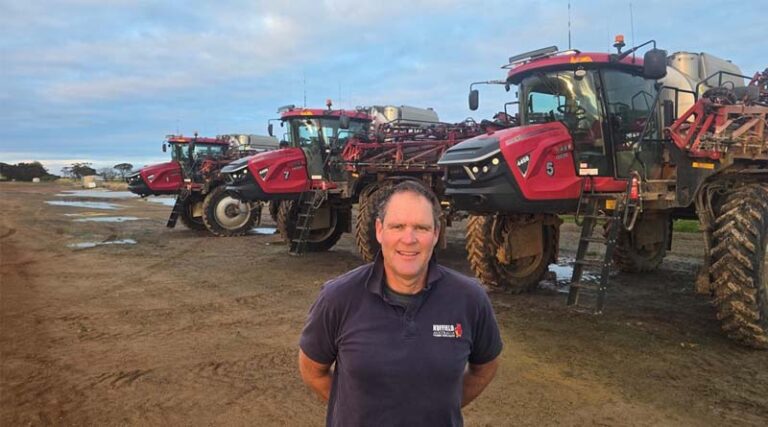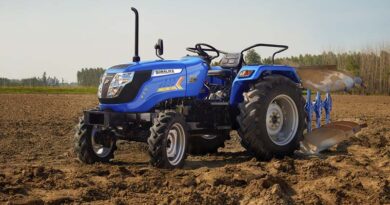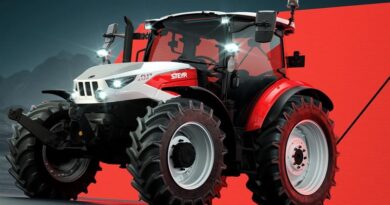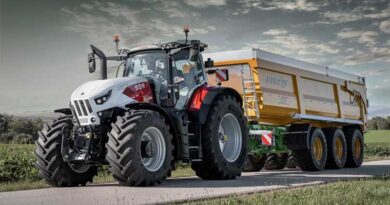
Esperance Cropping Business Has Its Challenges So Quality Machinery, Experienced Team Critical For Success
30 July 2025, Australia: Andrew Fowler lives in a beautiful part of Western Australia, but the location and environment can be challenging when you’re running a large-scale cropping operation, so having the resources and strategies to change direction with little notice is critical.
Andrew runs Chilwell Farms, about 90km east of Esperance in the south of WA. It’s 80% cropping with canola, wheat and barley and sometimes lupins, and 20% pasture, running sheep and cattle. A lot of the country is rotated with a vetch, serradella or clover-based pasture for a year or two, before returning to canola and wheat.
“There’s quite a bit of variation as you move around the property, so there’s some quite heavy clays and loams close to the coast, lots of typical Esperance sand over clay … and then as you head north and you go back into the more traditional Mallee country, it can be quite heavy. So there are differences, but fundamentally, for this Esperance area, there is a sort of a duplex nature to the soils with a tight clay subsoil,” Andrew said.
“The other thing to note is that the rainfall changes a lot. So right on the coast, we’re at 650mm because we go down to 2km from the beach. And then at the top of the farm, 45km to the north, it’s 400mm.”
Currently, Andrew and his team are managing 15,000 hectares of canola, the same of wheat and 8ha of barley. And they’ve seeded about 5000ha of vetch and rye grass pastures.
“With a variation in both rainfall and soil type, that requires different management strategies and different focuses,” Andrew said.
Some of the soils are relatively low in quality, he says, with a fairly low water-holding capacity, sodicity at depth and prone to compaction. On the sandier soil, there’s a non-wetting quality to it.
“So, we’ve spent a lot of time soil-improving and really I think the big leap up in
productivity from a cropping perspective has come from soil-improvement programs over the last decade or so. And that’s a combination of everything,” he said. “It includes deep-ripping to about 500mm on the sandier soils, and a lot of lime to get the pH levels up to where you need them.”
For this task, Andrew has nine Case IH Steiger Rowtracs among his fleet, and three Case IH Steiger tractors. The Rowtracs were well suited to the sandier soils, Andrew said, particularly when it got wet.
“We’ve put a lot of effort into decompacting with the sandier soil, and it’s a relatively expensive, slow operation, ripping to 500mm. We’re running a full 12m match CTF system and spraying and spreading on 36m, seeding and harvesting on 12m. The Rowtracs are really important for being able to start on 3m and have the capacity to pull the seeder bars, particularly when it’s a bit wet or if it’s soft sand that’s been deep ripped. Once you start getting bogged, it gets pretty painful and turns into hard work really quickly, so the Rowtracs help keep us moving,” he said.
Andrew also has eight Case IH Patriot sprayers split into two teams. There’s a core group of staff who support the spraying operation, which Andrew says is important when running a large number of sprayers and needing to prioritise particular tasks as the need arises.
The Patriots are running reasonably regularly – between 1000 and 1200 hours annually – with three of the Patriots equipped with spot-spraying technology.
“It’s a fairly high workload per sprayer. But we have a relatively intensive input program with our cropping when you consider multiple applications of fertiliser, applying fungicides, weed control – it certainly adds up to a lot of passes. And then there’s also activity around managing pastures as well, both in pasture and desiccation at the end of the season, and preparation at the start,” Andrew said.
“So, I don’t know that we could do it with any fewer sprayers. That’s the reality. We’re pretty busy all the time, particularly given our spraying windows are sometimes compromised with wind. Esperance can be a windy part of the world.”
Chilwell Farms is going into its third season with the Patriot fleet, and Andrew said they had been reliable and efficient to date.
“The individual nozzle control and the predictability and accuracy of application is really good. There’s no wasted chemical anywhere, which is so important for planning and for the efficiency of our operation.”
He also praised his local dealer, Farmers Centre in Esperance, for their quality service and support.
While there were challenges with the diversity of the area he’s farming, Andrew said that it also offered a degree of security, further supported by an expert team and large machinery fleet.
“It offers a bit of stability from a business perspective because, while you know it’s probably not going to be great everywhere, you also know it’s unlikely to be really bad everywhere. So that gives you a bit of security, and from an operational point of view, it provides flexibility,” he said.
“There may be some areas that are too dry or some areas too wet, but you can manage your operations by being nimble. So, we don’t have farm managers, we have operational managers who run the fleet of machinery where they need to be operating. You might focus on getting the heavy coastal country in before it gets wet and hard to manage, or you might be focused on getting the northern country in while the moisture is still in the slot.”
The season to date has been good, Andrew says, with most of the property getting between 30 and 50mm through April, and then after a fairly dry May, welcoming about 30mm towards the end of the month.
“For this time of year, things are looking pretty promising, but there’s still a long way to go,” he said.
📢 If You’re in Agriculture, Make Sure the Right People Hear Your Story.
From product launches to strategic announcements, Global Agriculture offers unmatched visibility across international agri-business markets. Connect with us at pr@global-agriculture.com to explore editorial and advertising opportunities that reach the right audience, worldwide.






